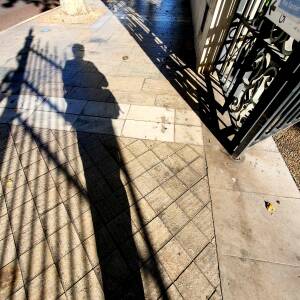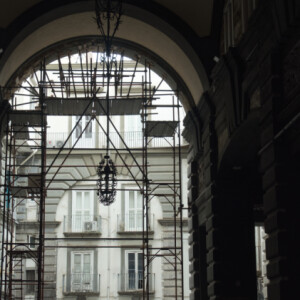In need of a seat
I was determined to be a slightly better organised tourist in Naples, so first headed for Spaccanapoli, the name given to an east-west run of narrow streets full of small shops and eating places. It was heaving with visitors and locals ambling, stopping and backtracking, and sidestepping mopeds and the occasional brave car.
It's clear, from the many ripped-up plastic bags fluttering in every street from cables and balconies and washing lines (extra 1), that Napoli football colours are pale blue and white. (I know you already knew that, but I didn't). There are often accompanying photos of Saint Maradona.
I paid homage to another touristy street: Via San Gregorio Armeno. Traditionally it was a street of workshops making model Christmas stables and their inhabitants. I was lucky enough to overhear a youngish Italian woman saying that when she was a child it was not a tourist trap but a December family outing treat to come here so the children could choose a new character or animal to add to the family stable. One workshop I passed had a notice saying that everything was made on site, but most were selling mass-manufactured figures.
The tour of Underground Naples was a fascinating revelation. In the fourth century BC, the Greeks needed stone for building and, astonishingly, quarried underneath where they wanted to build. The result is that Naples is built on a vast labyrinth of slave-made caverns and interconnecting tunnels. Once they'd extracted all the (volcanic) stone they could, these caverns became the drinking water cisterns for the city, filled by conduits and aqueducts. An hour's walk 40m below street level took us to, apparently, only 1% of the two million square metres of cisterns. We saw lots of overhead vertical 'wells' through which dwellings above would dip amphora on ropes to collect water. Disadvantage: the downwards access to water also provided upwards access to dwellings and thievery was rife. This system lasted 2,000 years until the early 20th century when the cisterns were drained and closed off. They came into use again in the Second World War when they were used as bomb shelters. Some of the passages we walked through, for 50 or more metres at a stretch, were too narrow to walk facing forwards and we had to sidle through the darkness. I very much doubt that would be allowed for the public in the UK. When we emerged at street level I thought I'd had well more than my money's worth, but that wasn't all. We walked through the streets to a house the shape of whose arches had interested a couple of archaeologists in the 1970s. They arranged to buy it from the old woman who lived there and found that the access under her bed to her wine cellar also gave access to a Greco-Roman theatre. Much of the stone from the theatre had been removed for other buildings in the 15th century and the rest of the theatre was incorporated into other buildings but we were able to see one of the excavated changing rooms.
An extraordinary visit, and I needed a slow walk to take it all in.
I remembered nothing from my previous visit of how the Archaeological Museum looked nor where it was, but I did remember some of the Pompeii frescos. I was learning Latin in the 1970s and was desperately excited then to recognise some of the Pompeii frescos from the Penguin Classics covers. Those images have accompanied me ever since and I was happy to see them again, along with many other frescoes and mosaics that I must have seen before but had forgotten. I was very taken by a small mosaic of a woman's head made of tesserae no bigger than 2mm. Pixels were invented so long ago...
Time to rest my feet. The Naples metro has commissioned artworks for several of its stations so I bought myself a 90-minute ticket intending to jump off at several stations then pick up the following train. I hadn't banked on the rush hour, so the resting-feet idea didn't work, but I got to see some fun stations (I liked Toledo and Università best) before my ticket expired.
10.5km



Comments
Sign in or get an account to comment.


